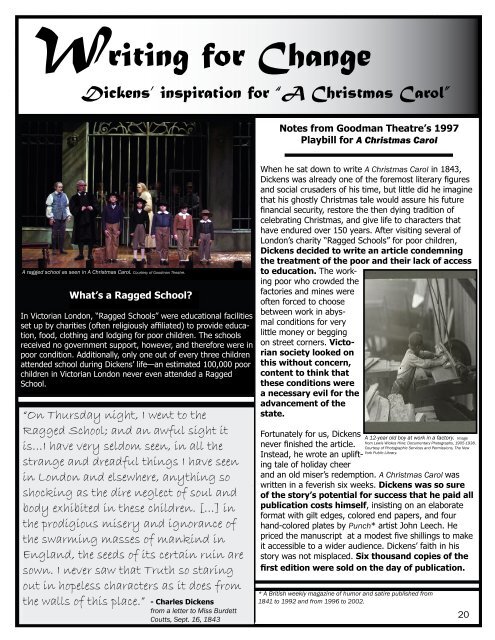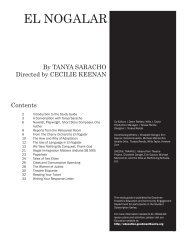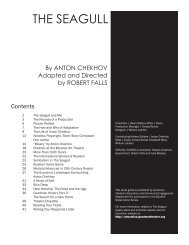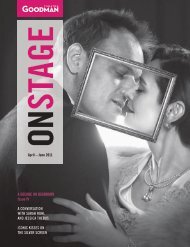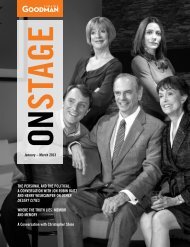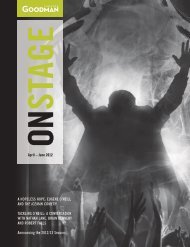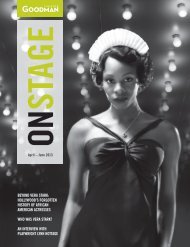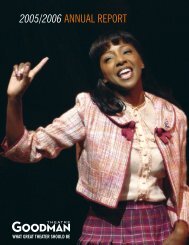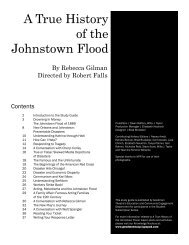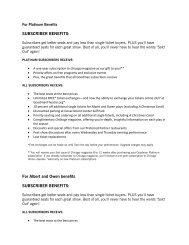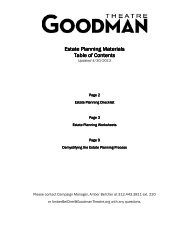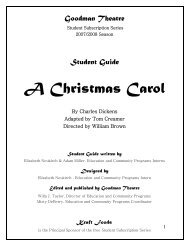A Christmas Carol Study Guide.indd - Goodman Theatre
A Christmas Carol Study Guide.indd - Goodman Theatre
A Christmas Carol Study Guide.indd - Goodman Theatre
You also want an ePaper? Increase the reach of your titles
YUMPU automatically turns print PDFs into web optimized ePapers that Google loves.
Writing for Change<br />
Dickens’ inspiration for “A <strong>Christmas</strong> <strong>Carol</strong>”<br />
Notes from <strong>Goodman</strong> <strong>Theatre</strong>’s 1997<br />
Playbill for A <strong>Christmas</strong> <strong>Carol</strong><br />
A ragged school as seen in A <strong>Christmas</strong> <strong>Carol</strong>. Courtesy of <strong>Goodman</strong> <strong>Theatre</strong>.<br />
What’s a Ragged School?<br />
In Victorian London, “Ragged Schools” were educational facilities<br />
set up by charities (often religiously affiliated) to provide education,<br />
food, clothing and lodging for poor children. The schools<br />
received no government support, however, and therefore were in<br />
poor condition. Additionally, only one out of every three children<br />
attended school during Dickens’ life—an estimated 100,000 poor<br />
children in Victorian London never even attended a Ragged<br />
School.<br />
“On Thursday night, I went to the<br />
Ragged School; and an awful sight it<br />
is…I have very seldom seen, in all the<br />
strange and dreadful things I have seen<br />
in London and elsewhere, anything so<br />
shocking as the dire neglect of soul and<br />
body exhibited in these children. […] in<br />
the prodigious misery and ignorance of<br />
the swarming masses of mankind in<br />
England, the seeds of its certain ruin are<br />
sown. I never saw that Truth so staring<br />
out in hopeless characters as it does from<br />
the walls of this place.” - Charles Dickens<br />
from a letter to Miss Burdett<br />
Coutts, Sept. 16, 1843<br />
When he sat down to write A <strong>Christmas</strong> <strong>Carol</strong> in 1843,<br />
Dickens was already one of the foremost literary figures<br />
and social crusaders of his time, but little did he imagine<br />
that his ghostly <strong>Christmas</strong> tale would assure his future<br />
financial security, restore the then dying tradition of<br />
celebrating <strong>Christmas</strong>, and give life to characters that<br />
have endured over 150 years. After visiting several of<br />
London’s charity “Ragged Schools” for poor children,<br />
Dickens decided to write an article condemning<br />
the treatment of the poor and their lack of access<br />
to education. The working<br />
poor who crowded the<br />
factories and mines were<br />
often forced to choose<br />
between work in abysmal<br />
conditions for very<br />
little money or begging<br />
on street corners. Victorian<br />
society looked on<br />
this without concern,<br />
content to think that<br />
these conditions were<br />
a necessary evil for the<br />
advancement of the<br />
state.<br />
Fortunately for us, Dickens<br />
never finished the article.<br />
Instead, he wrote an uplifting<br />
tale of holiday cheer<br />
A 12-year old boy at work in a factory. Image<br />
from Lewis Wickes Hine: Documentary Photographs, 1905-1938.<br />
Courtesy of Photographic Services and Permissions, The New<br />
York Public Library.<br />
and an old miser’s redemption. A <strong>Christmas</strong> <strong>Carol</strong> was<br />
written in a feverish six weeks. Dickens was so sure<br />
of the story’s potential for success that he paid all<br />
publication costs himself, insisting on an elaborate<br />
format with gilt edges, colored end papers, and four<br />
hand-colored plates by Punch* artist John Leech. He<br />
priced the manuscript at a modest five shillings to make<br />
it accessible to a wider audience. Dickens’ faith in his<br />
story was not misplaced. Six thousand copies of the<br />
first edition were sold on the day of publication.<br />
* A British weekly magazine of humor and satire published from<br />
1841 to 1992 and from 1996 to 2002.<br />
20


